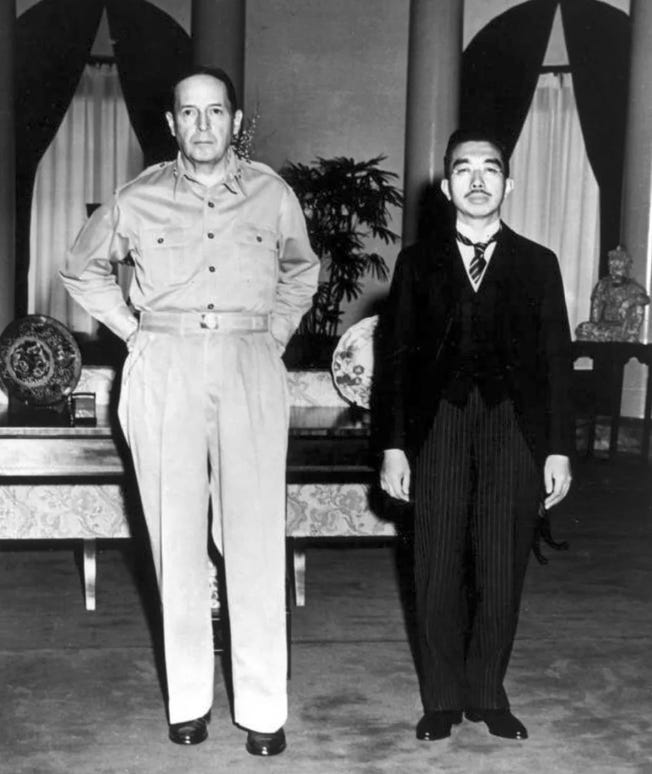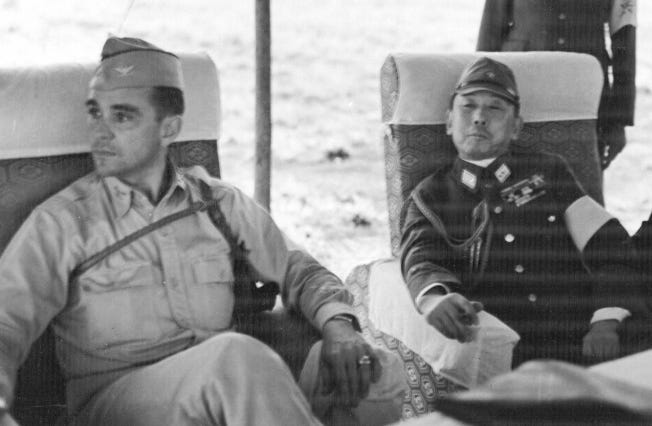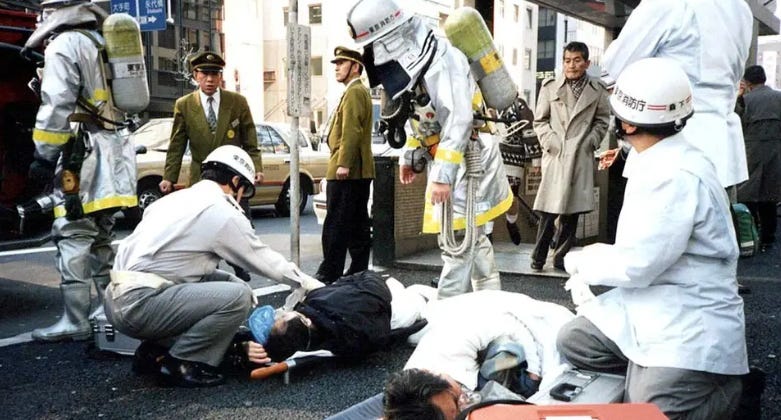People are often surprised that the Japanese accepted the Allied Occupation so readily after war’s end. Hadn’t they been taught to believe their country was locked in an existential struggle with powerful and malevolent enemies? Hadn’t they been told to fight to the very end, defending their homeland?
Yes - but…
By the summer of 1945, people were exhausted. They had lost family and homes, and were reduced to foraging for food. It hadn’t escaped their notice that their government exhorted them to fight while failing to do its bit in their defence. Precious aircraft and artillery were diverted abroad, leaving American bombers cruising over Japanese cities at chimney-top height and dropping as much napalm as they could carry. Many tens of thousands of lives were lost.
For these and other reasons besides, in the wake of surrender people in Japan were increasingly inclined to find power and malevolence not on the other side of the Pacific but in government ministries in Tokyo - from where thick black smoke poured out during the summer of 1945 as officials hurried to destroy incriminating documents before the first Americans made it ashore in late August.
The aims of the Occupation, led by the US and by General Douglas MacArthur in particular, boiled down to the Three Ds: demilitarization, democratization and the decentralization of political and economic power.
Staffed in large part by idealistic young Americans, determined to remake Japan in America’s image, the Occupation at first struck Japanese conservatives as a worryingly left-of-centre affair. The military was disbanded. Trade unions were soon back in business. Socialists and communists were out of prison and organising rallies. Women had the vote. New legislation on property rights and divorce threatened the traditional, patriarchal Japanese family. And the Emperor was forced to relinquish his claim to divinity.
Douglas MacArthur - nicknamed the ‘Blue-Eyed Shogun’ - looms over Emperor Hirohito in a photo taken in September 1945. So vividly did the image symbolise the weakness of Japan after the war that Japanese politicians tried - and failed - to prevent its publication.
Things changed in the late 1940s and early 1950s, with the souring of US-Soviet relations, the rise of China and the outbreak of the Korean War. At American instigation, Japan acquired the euphemistically-named National Police Reserve. Officially, the NPR’s job was to tackle domestic insurrection. But the Americans, who equipped it and sought its enlargement, regarded it as the nucleus of a future Japanese army (intended to work alongside its US counterpart, now that the two countries had moved from enemies to allies). And indeed it would have been an impressive domestic insurrection whose quelling required the use of bazookas, flame-throwers, mortars, tanks and artillery.
The NPR later morphed into the Self-Defence Forces - and attracted a good deal of controversy because Japan’s new constitution forbade the maintaining of the means to wage war.
No less fraught was the question of how the new Japan ought to go about gathering and using intelligence. A population that had learned to live in fear of the Special Higher Police and the Kempetai, alongside the draconian demands made on their lives and loyalties by Japan’s wartime leaders, were implacably opposed to anything that looked like a return to those bad old days. Calls were made but soon had to be dropped for the creation of a Japanese FBI.
People were right to be worried. Officials from the wartime Home Ministry, some of whom had overseen the work of the Special Higher Police, were still in their jobs. Meanwhile, though lots of senior Japanese military and political figures were quickly rounded up by the Americans to await trial, others roamed free and began to plan an insurgency. Amongst them was Arisue Seizō, the former chief of Army intelligence. He drip-fed the Americans useful information and helped to interrogate Japanese soldiers returning from war, while at the same time protecting allies and hoarding money and weapons in preparation for an attempt - one day - to take back Japan.
Arisue Seizō pictured on 28th August 1945 - the first day of the Occupation - looking for all the world like a man who knows something the man sitting next to him doesn’t…
The result of this powerful popular opposition was the development over the decades that followed of a jumble of agencies - including a Cabinet Research Office and a Public Security Intelligence Agency - which didn’t always talk to one another and which collectively trained and dispatched very few agents for work out in the field. Japan came to rely heavily on imperfect relationships with American intelligence services. It was only when a series of tragic incidents hit the two countries in the years after the Cold War ended that things really began to change.
One of the first was the sarin gas attack launched on the Tokyo metro by the religious doomsday cult Aum Shinrikyō in March 1995. Thirteen people died and many more were injured. It was the worst terrorist attack in postwar Japanese history. And yet when people asked why the Public Security Intelligence Agency hadn’t seen this coming, it turned out that it was forbidden under the law from carrying out investigations that restricted religious freedom.
Aftermath of the sarin gas attack on the Tokyo underground, March 1995
Three years later, in 1998, Japanese intelligence failed to predict or detect the launch of a North Korean missile, which flew over Hokkaidō and landed in the Pacific. Then along came 9/11, causing some in Japan to wonder whether if US intelligence couldn’t prevent an attack on American soil it could possibly prevent one on Japan. The weakness of Japanese intelligence in the Middle East and North Africa was exposed across the 2000s, as a number of Japanese citizens were kidnapped and in some cases executed.
The cumulative effect of incidents like these, added to the rise of China and ongoing pain in Japan over the abduction of citizens by North Korean agents back in the late 1970s and 1980s - potentially numbering in the hundreds - was a wearing-away of hostile public opinion towards intelligence services. By 2013, Prime Minister Abe Shinzō found himself in strong enough a position with the electorate to give Japan the intelligence and security arrangements that it has today.
Japan soon got a new National Security Council, alongside a National Security Secretariat to support it with intelligence gleaned from across Japan’s civil and military agencies. The Prime Minister sat at the top of everything. Meanwhile, a Designated State Secrets Law was passed, similar to measures enacted in the US and UK, to ensure that intelligence, once collected, was less likely to leak. Even then, Abe had to alter his proposals in the face of lingering opposition to what still smelled, to some, like the beginning of a return to the bad old days. Parliamentary oversight of Japan’s now much-improved intelligence apparatus remains a major political issue.
MI6 had been studied for years in Japan as a possible model for an overseas intelligence agency, as had the Australian Office of National Assessments (now the Office of National Intelligence). But even with Abe’s unassailable poll lead, a single agency dedicated to covert overseas intelligence collection and action along the lines of MI6 was too big an ask of the Japanese public. To this day, Japan lacks such an agency - but this could change.
It won’t come at the hands of Abe, who retired as Prime Minister in 2020. Two years later, in what might yet prove to have been a failure of Japan’s intelligence services, he was assassinated while out campaigning for his Liberal Democratic Party.
What seems likely instead, in the coming years, is a deepening of Japan’s security relationships with allies like the UK, wedded to increased military spending. In April this year, Japan agreed to start providing geospatial intelligence data to Ukraine. And earlier this month it proposed doubling what it spends on its military: from 1% to 2% of GDP by 2027. As the pacifist Japan of the postwar years steadily recedes and America’s position in the world continues its slow decline, a future Prime Minister may well find that he or she can revive the proposal for a Japanese MI6.
It might even be that popular culture ends up playing a modest role. While the Japanese Self-Defence Forces famously resorted, a few years ago, to creating mascots to help win a little public affection, one of the most successful manga and anime series of recent years is Spy x Family. It features a covert intelligence agent - Loid Forger - who creates a fake family to help him bring peace to two rival nations.
Left: Spy x Family. Right: the SDF’s ‘Prince Pickles’
There’s no obvious path from Spy x Family to a Japanese MI6. But in Japan, the idea of an intelligence agency capable of acting abroad in the country’s interests is becoming less and less taboo. If the pattern of the past is repeated, it may in the end take some new disaster to finally make it happen.
Images
MacArthur and Hirohito: Wikimedia (public domain).
Arisue Seizō: Richard J Samuels, On Special Duty: A History of the Japanese Intelligence Community (fair use).
Aftermath of the sarin gas attack on the Tokyo underground, March 1995: BBC (fair use).
Spy x Family: Crunchyroll (fair use).
Prince Pickles: Reason/Artifact (fair use).
Further Reading
Richard J Samuels, On Special Duty: A History of the Japanese Intelligence Community (2019).
‘Japan Eyes MI6-style spy agency as it seeks to shed pacifist past,’ Reuters, March 2025.
Nicholas Fishlock, ‘The Development of Japan’s Intelligence Policy in the 21st Century’, ISDP, June 2019.







Great read and I loved the Spy Family reference!
Japan does fine with IMINT (or GEOINT as it is called now) and SIGINT, but it has hesitated to get invoved in HUMINT activities. I understand that the PSIA has been pushing to send its people overseas and may be the only viable HUMINT service now. It's been trying to make up for its disastrous failure to pay attention to Aum Shinrikyo and to justify its existence in a society lacking internal threats.